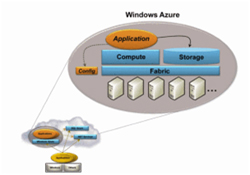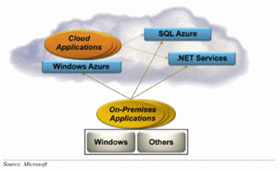Microsoft Windows Azure is an enterprise grade platform offering Software as a Service (SaaS) in cloud computing. It offers cloud and a development service to build applications that covers end-to-end web and enterprise scenarios.
Organization has multiple systems and technology to run business processes. Implementing well defined and planned Windows Azure Platform unleash below benefits to organization :
- Reduce Capital & Operational cost by Pay-As-You-Grow concept
- Enables business Agility and Efficiency
- Bridge gap between web technology, support for multiple web platforms and languages
- Enterprise class reliable, efficient service offerings and agreements
- Interoperability with industry standard data exchange protocols (HTTP, SOAP, REST, RSS...)
- Geographically distributed data centers and strategic locations

Microsoft, after talking about it endlessly, has finally opened up its cloud platform, Windows Azure, for business. Windows Azure and SQL Azure are now available in 21 countries worldwide, the company said. So today the rubber meets the road — and we get to see how Azure does in the marketplace.
What will Azure’s financial impact be? It’s hard to say, but I think it’s safe to assume that Microsoft, which has gotten used to the 50 percent (or higher) margins on its products, will see those margins shrivel in the face of the competition. Azure is joining a crowded marketplace, one dominated by Amazon and its web services, which now boasts of thousands of developers in addition to an entire ecosystem.

And if that wasn’t enough, Azure will be competing with offerings from IBM, Cisco Systems, EMC Corp. and VMware, Rackspace and other small players. Microsoft says it’s not worried, though and claims companies like 3M and GXS are already using the Azure cloud.
Not only are established partners and ISVs looking to the Windows Azure platform as a way to extend their revenue capabilities, but startups like Lokad are betting their businesses on it. Lokad has deployed a scalable forecasting cloud-based service to its retail and manufacturing customers that provides real-time forecasting data to allow for inventory optimization and ultimately bring them to profitability.
Notably, Microsoft’s Azure is part of Redmond’s “software-plus-services” strategy that also includes its Hyper-V server virtualization platform launched in October 2009. Microsoft also sells Windows Live, Microsoft Office Live, Business Productivity Online Suite, and Microsoft Dynamics CRM as SaaS, making it part of the company’s larger cloud strategy.

Given how closely we at SSS have followed the Azure saga, I thought it would be good to highlight some of our past coverage containing relevant details about Azure and Microsoft’s plans.
- Windows Azure is a cloud operating system on which developers can build using .NET, Java, Ruby on Rails, Python and other languages. (From Everything You Need to Know about Microsoft’s Azure).
- Compared to infrastructure-as-a-service providers such as Amazon with Ec2 or Rackspace with its CloudServers products, Azure attempts to handle more of the actual management and provisioning of virtual machines for a user. (From Microsoft Azure Walks a Thin Blue Line)
- If we view the data center as akin to a machine, Microsoft wants folks to be able to create applications that can run on a Microsoft Azure cloud or internally on an in-house cloud. Newly launched AppFabric is the solution for that. AppFabric is software that folks can run in their own data center to create an internal cloud that can talk to and share information with the public Azure cloud if the client wants. (From Stacey’s Microsoft Azure Walks a Thin Blue Line)
- SSS thinks that AppFabric is the big edge for Microsoft. In a note he writes (subscription required): “Windows Server AppFabric will help users build application fabrics in their Windows environments to minimize the complexity of delivering enterprise applications as services. AppFabric achieves this through supporting Restful or SOAP-based services, workflows and application-level monitoring. Additionally, AppFabric marks the first commercial presence of Microsoft’s distributed in-memory caching technology (codenamed ‘Velocity’). Its inclusion ensures that apps can scale at will without experiencing performance bottlenecks at the data layer.”
